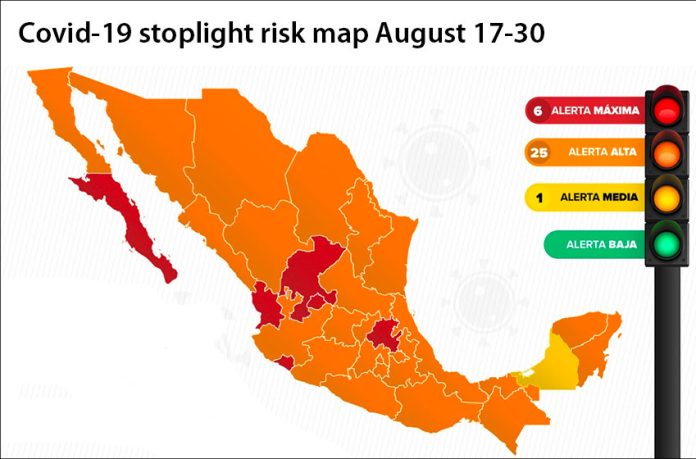Campeche is the first state in Mexico to move from orange to yellow on the federal government’s coronavirus “stoplight” risk map, meaning there will be no restrictions on economic activities.
As of Monday, all businesses and public spaces in the state can open, although people at high risk, such as those with high blood pressure, diabetes, or other comorbidities, should continue to take extra precautions. Enclosed public spaces must operate at reduced capacity.
The next phase is green, meaning all activities, including schools, can return to normal operations.
Over the past two weeks, Campeche has seen a 23% decline in new cases and the state’s government has been proactive in combating the spread of the disease.
One tactic that appears to have proven effective was the formation of community brigades made up of doctors, pharmacists, nurses and social workers from the Ministry of Health. They have been testing people suspected of having the disease, monitoring those who are infected and conducting contact tracing.
According to the federal government, as of August 14 Campeche had recorded 5,120 accumulated cases of the coronavirus and 663 deaths, and there were 150 active infections, who are patients who have had symptoms within the last 14 days.
Campeche’s rate of infection is 21.69 per 1,000 inhabitants, below the national average of 35.20 per 1,000, but by no means the lowest in Mexico. That honor goes to Chiapas, where the reported rate of infection is just 2.73 per 1,000, whereas Baja California Sur maintains the highest rate of infection per capita at 143.29. The latter, tourism-dependent state is listed as red on the federal coronavirus map but has chosen to operate at the orange level.
Other states that will remain red are Nayarit, Zacatecas, Colima and Hidalgo, while Aguascalientes will move from orange to red.
States that have seen an improvement in the Covid-19 situation and will move from red to orange are Coahuila, Durango, Jalisco, Michoacán, Nuevo León, Puebla, San Luis Potosí, Tabasco, Tamaulipas, Veracruz and Yucatán.
Mexico City will remain at the orange level for the eighth week in a row, said Mayor Claudia Sheinbaum, who is self-isolating after coming in contact with a cabinet member who tested positive for the coronavirus.
“This coming week we are permitting the same activities. It is important to see what the impact is of the activities that have already reopened,” Sheinbaum said. “If everything continues as we hope it will, which depends on the participation of everyone, we will be reopening more activities.”

Deputy Health Minister and coronavirus czar Hugo López-Gatell said it took 123 days for the coronavirus to peak in Mexico, which has helped hospitals manage care as the number of confirmed cases has begun a slight decline.
“When we have a slow epidemic, which is the goal we set in Mexico, we seek to have fewer sick people per day, which does not saturate hospitals. But that does not mean that the epidemic disappears, the risk is deferred and the epidemic is organized so it can be controlled more effectively and unnecessary deaths can be avoided,” he said.
Health officials reported that as of Friday, 150 days since the start of the pandemic in Mexico, the country has registered 511,369 confirmed cases of the coronavirus, up 5,618 from Thursday. There were 615 deaths reported Friday, bringing the total of fatalities to 55,908.
José Luis Alomía, the Ministry of Health’s director of epidemiology, stated that 345,653 Mexicans have recovered from the virus, and general hospital occupancy stands at 39%, with 66% of the beds with ventilators available. Colima has the highest hospital occupancy rate at 66%, followed by Nuevo León at 64% and Nayarit with 62%.
Source: El Universal (sp), Infobae (sp), Expansión Política (sp), Milenio (sp)
